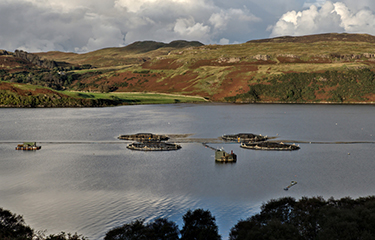The latest data published by the Scottish government has confirmed that the country’s trout and salmon production saw a significant bump in 2019 compared to the same period in 2018.
According to the Scottish Fish Farm Production Survey 2019, compiled by Marine Scotland Science, the total volume of Atlantic salmon produced by Scottish fish farmers increased by 30.7 percent, or 47,856 metric tons (MT), to 203,881 MT last year. The country also saw its rainbow trout harvest rise by 15 percent to 7,405 MT, and its brown trout/sea trout production increase by 5 MT to 25 MT.
At the same time, the number of people employed in marine salmon production increased by 185 to 1,651 staff.
Eight companies actively produced Atlantic salmon in 2019, the same number as the previous year. Three companies remained active and authorized but did not produce any salmon for harvest, which continued the trend of Atlantic salmon production becoming concentrated within fewer companies.
Collectively, these 11 companies had 226 registered active sites.
There were three incidents involving the loss of 28,470 fish from seawater Atlantic salmon sites in 2019. There were 16 additional incidents reported where the companies confirmed there was no loss of fish.
The projected estimate for 2020 is that Scottish salmon production will increase to 207,630 MT.
In 2019, freshwater production was undertaken by 23 businesses at 76 sites, with the number of active sites increasing by five compared with 2018.
The total number of smolts produced in 2019 increased by 9 percent to 51.4 million. The number of ova laid down to hatch was up by 1.1 percent to 71.2 million with the 89.7 percent derived from foreign sources.
With regards to escapes, there was one incident involving the loss of 4,465 fish from a site rearing freshwater Atlantic salmon.
Scotland’s aquaculture industry also continued to farm other species of fish last year. Lumpsucker and various species of wrasse were cultured for use as biological controls for parasites in the marine salmon industry. In total, 660,000 lumpsucker and 59,000 wrasse were produced.
While halibut was also farmed during 2019, Marine Scotland did not disclose this volume, stating that it would reveal the production of an individual business.
The number of staff employed in other species production decreased by seven, to 53 persons.
Commenting on the new survey, Scotland’s Rural Economy Secretary, Fergus Ewing, said the latest figures show record levels of salmon being produced by fish farms, and that the finfish sector is on track to achieve its sustainable growth target of 210,000 MT by 2020.
“With increased jobs and stock across all farmed fish, I congratulate the sector for its efforts, delivering unprecedented production of this nutritious, quality seafood and creating more highly-paid, highly-skilled jobs in many of our most remote and fragile communities,” Ewing said. “I look forward to salmon maintaining its place as Scotland’s biggest food export, as a key contributor to our food and drink success story which in turn is supporting the wider supply chain. With the impact of coronavirus and threats from Brexit, we will do all we can to support the sector and the benefits it brings, working to drive improvements in research, innovation, and regulation to deliver further sustainable growth.”
Photo courtesy of Phil Silverman/Shutterstock







